Model 93, 8 x 6° 15′
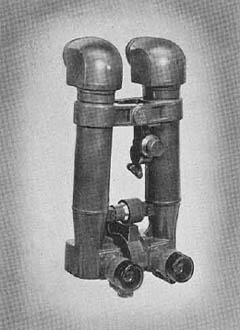
The eyepieces are of the multiple thread focusing type, and the diopter scale is graduated from +2 to -3. The reticle design consists of a vertical and horizontal mil scale graduated in increments of one mil from 0 to 30 on each side of 0. A light receptacle for artificial illumination of the reticle is provided.
The telescope is fitted with an angle of site mechanism. The hinge mechanism of the assembly consists of a simple hinge pin and a fitted yoke. The interpupillary mechanism is locked near the base and between the two tubes.
Telescope with Integral Tripod
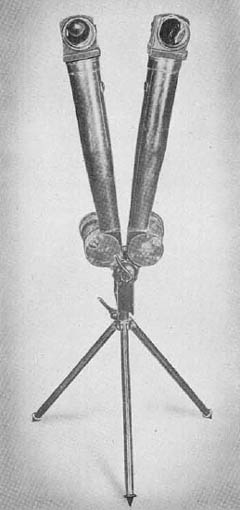
The reticle is the only angle measuring device provided. The limit for horizontal angles is 30 mils to the right and 10 mils to the left of zero. Vertical angles of plus and minus 20 mils can be measured. The 90° prisms are cemented. Minimum and maximum interpupillary distances are 60 mm and 70 mm.
The tripod is simply constructed, light in weight, and sturdy. It comprises an adapter or bracket for the telescope, a tripod head, and three tubular, fixed length legs with small metal shoes.
SPECIFICATIONS
| Model 93 | Tel. with Int. Tripod | |||
| Power | 8 diameters | 8 diameters | ||
| Field of view | 6° 15′ | 6° | ||
| Interobjective distance | 3 3/4 ins. | |||
| Interpupillary setting | 58 to 70 mm | 54 to 70 mm | ||
| Deviation of light in vertical plane | 10 ins. | 9 ins. | ||
| Diameter of Exit Pupil | .2 ins. | .15 ins. | ||
| Overall length | 12 3/4 ins. | 12 ins. | ||
| Overall width | 6 1/4 ins. | |||
| Weight | 6 lbs., 5 ozs. | 2 lbs., 2 ozs. | ||
| Length of tripod | 11 13/16 ins. | |||
| Weight of tripod | 11 ozs. |
*The interobjective distance with the tubes horizontal, and the interpupillary scale set at 64 mm is 21 ins.; with the tubes vertical, and the interpupillary scale set at 64 mm, the interobjective distance is 5 ins.
Japanese: p. 178 (March 1, 1945)
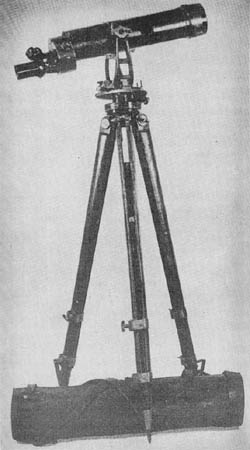 The Japanese multiple power observation telescope has three powers: 33X, 24X, and a third degree of magnification which has not been determined because of the absence of a third eyepiece in the instrument examined. Selection is made by rotating a dome-shaped holder in which the three eyepieces are mounted. This is somewhat similar to the turret head employed in motion picture cameras and to the selective eyepiece head of compound microscopes.
The Japanese multiple power observation telescope has three powers: 33X, 24X, and a third degree of magnification which has not been determined because of the absence of a third eyepiece in the instrument examined. Selection is made by rotating a dome-shaped holder in which the three eyepieces are mounted. This is somewhat similar to the turret head employed in motion picture cameras and to the selective eyepiece head of compound microscopes.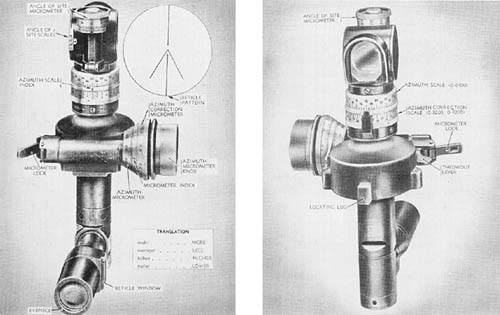
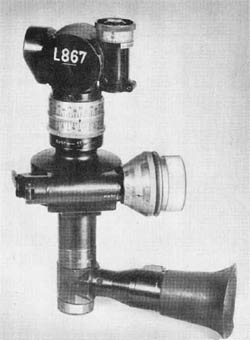 This panoramic telescope is used on all standard field equipment. It is a 4-power, fixed-focus type with a field of view of 10 degrees. The line of sight may be raised or lowered by rotation of the angle of site knob. The angle of site scale is graduated from 100 mils to 500 mils (300 mils in normal). The angle of site micrometer is graduated in mils from 0 to 100 mils. The azimuth scales on the vertical barrel of the telescope are graduated in 100-mil intervals; the upper scale, 0 to 64, is fixed in relation to the rotating head. The lower has two semi-circular scales numbered 0 to 32 and can be rotated independently of the rotating head. A knurled portion permits adjustment. The azimuth micrometer includes two scales graduated in mils from 0 to 100 mils. The outer scale can be rotated independently of the azimuth worm. Evidently the fixed azimuth scale and micrometer are used for initial laying of the piece and the second scale and micrometer are then zeroed and used to measure base deflection. A throw-out lever is provided for rapid setting in azimuth. A locking lever locks the azimuth micrometer in any setting. The reticle pattern is shown above.
This panoramic telescope is used on all standard field equipment. It is a 4-power, fixed-focus type with a field of view of 10 degrees. The line of sight may be raised or lowered by rotation of the angle of site knob. The angle of site scale is graduated from 100 mils to 500 mils (300 mils in normal). The angle of site micrometer is graduated in mils from 0 to 100 mils. The azimuth scales on the vertical barrel of the telescope are graduated in 100-mil intervals; the upper scale, 0 to 64, is fixed in relation to the rotating head. The lower has two semi-circular scales numbered 0 to 32 and can be rotated independently of the rotating head. A knurled portion permits adjustment. The azimuth micrometer includes two scales graduated in mils from 0 to 100 mils. The outer scale can be rotated independently of the azimuth worm. Evidently the fixed azimuth scale and micrometer are used for initial laying of the piece and the second scale and micrometer are then zeroed and used to measure base deflection. A throw-out lever is provided for rapid setting in azimuth. A locking lever locks the azimuth micrometer in any setting. The reticle pattern is shown above.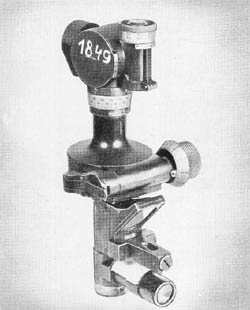 The Panoramic Telescope Rbl. F. 16, which has been replaced by the Rbl. F. 32 and 36, is still used on the
The Panoramic Telescope Rbl. F. 16, which has been replaced by the Rbl. F. 32 and 36, is still used on the